Picking the best trail running shoes of 2025 is no easy task. There are so many great trail running shoes these days, but we cut through all of them in this article and pick those that will give you the best performance based on fit, drop, weight, pros and cons, and more.
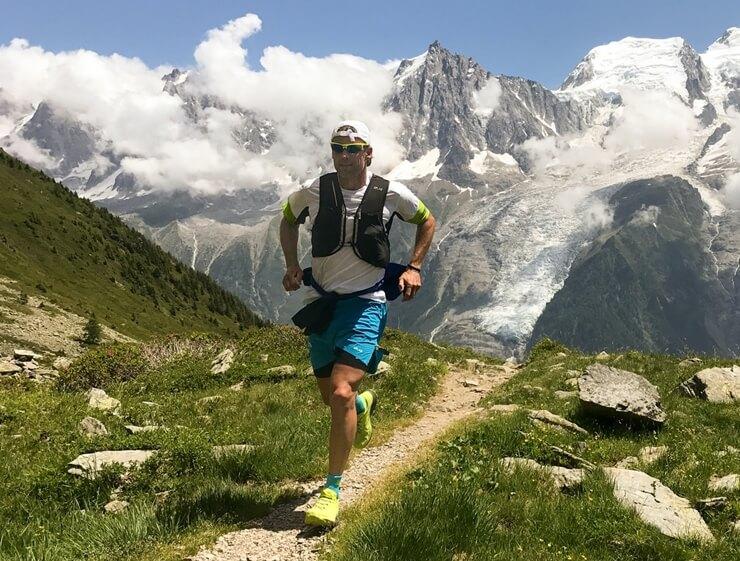
By: Camping Feed Staff | Last Updated: Jan. 26, 2025
This is the Camping Feed Staff’s rundown of the best trail running shoes of 2025. The trail running shoe market is booming, and our favorite shoes keep getting better. The sport continues to explode in popularity, and there are now more excellent products available than ever before.
Each shoe in this guide has something to offer: some are fast, some are for muddy trails, some are for long runs, some will help you go farther than you ever thought possible. Most of these shoes fall into the “trail trainer” category—they’re comfortable enough and light enough for daily training runs but still rugged enough for mountain races and long-distance events.
Picking shoes that work for you is highly personal, and our picks are only suggestions. But there’s a good chance one of these models is right for you, so we recommend starting here. Check out our trail running shoe reviews below. Also, if you want a better understanding of what to look for in your trail runners and the intricacies of this vital gear, we have included a guide to trail running shoes; keep reading!
Best Overall Trail Running Shoe
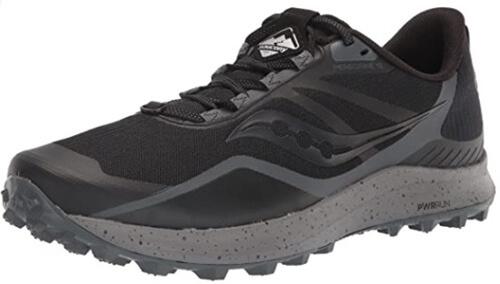
1. Saucony Peregrine 12
- Weight: 9.7 oz
- Drop: 4 mm
- Best for: Trail running, long-distance, fast running
- Pros: Excellent fit, soft materials, enough space to be comfortable, but locked in and secure
- Cons: Bit firm on hard surfaces such as pavement
The Peregrine 12 is an excellent update and a performant, race-ready, technical trail shoe. It is appropriate for different speeds, from jogging to racing on intermediate to specialized topography. It has a locked-in but comfy fit, a stable and quick ride, and 10/10 traction. It uses reclaimed materials in the upper and has an innovative style that is radiant and vibrant but not too flashy.
This shoe is a ride that can take you anywhere from any distance. The upper is incredibly soft and allows your foot to breathe. The mesh material is durable and will keep up with you on the trails for many miles. It is also extremely lightweight, which adds to the shoe’s overall comfort. If you’re looking for a shoe with a wider toe box, this is the one you’ve been waiting on. Overall this is an excellent all-around shoe that provides excellent support, traction, durability, and comfort at an unbeatable price.
It is almost identical to the Peregrine 11 except for a few tweaks here and there. In addition, some changes affect its performance: new lugs with more directional change in design; 5mm drop rather than 4mm drop; slightly lighter weight; midsole material revised with more firmness under the heel; upper materials revised; minor profile tongue; use of recycled materials in the upper; removal of anti-gravel tongue construction; mesh wraps around midfoot instead of perforated fabric.
The traction on this shoe is fantastic. The outsole is tacky PWRTRAC rubber — perhaps Saucony’s best compound — and it has deep lugs with lots of directional change to go up or down any hill or root you can imagine.
Best Trail Running Shoes For Hiking
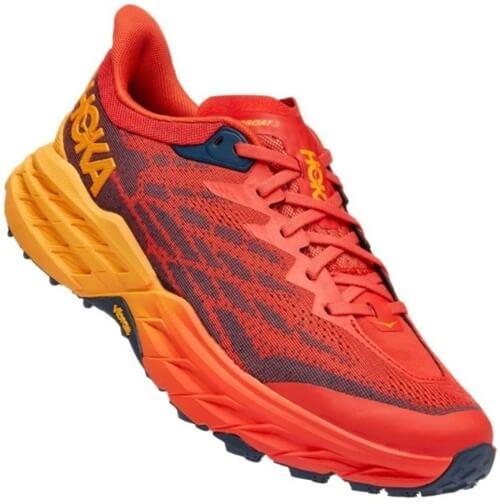
2. Hoka One One Speedgoat 5
- Weight: 10.79 oz.
- Drop: 4mm
- Best for: trail hiking/running/walking
- Pros: nice airflow, half the weight of a traditional hiking boot, stable on uneven terrain
- Cons: not as much ankle support
The Speedgoat 5 is the next generation of this all-around running shoe. It will be suitable for a wide range of terrains. An improved Vibram MegaGrip outsole will offer excellent traction and grip on dry and wet surfaces. In addition, the uppers have been improved to keep debris out with better fit and structure.
The Speedgoat 5 will be an excellent trail running shoe ideal for all types of terrains, including mud, gravel, snow, and even rocks. It has a flexible rock plate in the midsole to protect your foot from sharp objects on the ground. This makes it ideal for other outdoor activities such as hiking and light walks.
The heel collar will be padded with a soft material to reduce pressure on the Achilles tendon. The tongue will be gusseted to prevent debris from entering at the top. The midsole will have a supportive post on the medial side to prevent overpronation and ankle rolls when traversing uneven terrain or descending hillsides or mountains.
The Speedgoat 5 will be an all-around technical trail running shoe that can handle any terrain or weather conditions you throw at it. What sets it apart from other shoes in its class is its versatility and durability. This shoe is ready for the trail or any different terrain you take it on.
The expected release date for the Hoka One Speedgoat 5 was on October 18, 2022.
Best Waterproof Trail Running Shoes
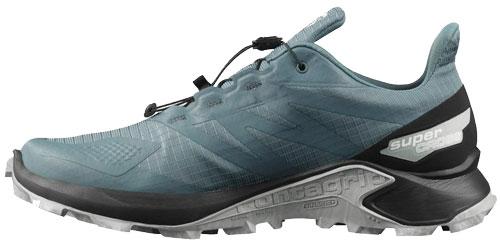
3. Salomon Supercross Blast GTX
- Weight: 11.99oz
- Drop: 10mm
- Best for: All Terrain Running
- Pros: Waterproof upper, Well-cushioned, Quick lacing, good gripped for wet conditions
- Cons: Relatively heavy
When you’re ready to take on the trail on a rainy, muddy day, the Salomon Supercross Blast GTX gives you everything to run fast and fearlessly. Whether it’s a lap around your park, an escape to the local trail, or something more rugged, this shoe will grip on all terrains while offering adequate waterproofing to make every run tremendous and dry.
The Salomon Supercross GT is a trail running shoe that combines precision fit with a responsive ride. The upper of the Salomon Supercross GT features textile and synthetic overlays that allow the foot to move naturally while still providing support and structure. The SensiFit™ nestles the foot from the midsole to the lacing system, providing a protected, tight, and virtually customized fit all around the foot. In addition, an OrthoLite® sock liner combined with an EVA-shaped footbed for supreme comfort underfoot.
The outsole features XS Trek technology which uses a mixture of rubber compounds to provide grip and durability. The Contagrip® sole offers additional grip on rough or wet terrain. In addition, the GORE-TEX® protects against water ingress while allowing excess heat and moisture to escape, creating a drier, more relaxed, and more comfortable environment for your feet.
Best Road To Trail Running Shoes
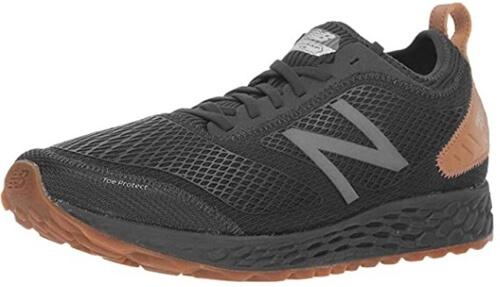
4. New Balance Fresh Foam Gobi V3
- Weight: 19.5oz.
- Drop: 6mm
- Best for: Cross over Trail Shoe
- Pros: Affordable, very lightweight, keep out debris
- Cons: Not water-resistant
New Balance has been in the running shoe business for over a century, and the Fresh Foam Gobi v3 represents a good combination of quality and affordability.
It is a reasonably light shoe with a 6mm drop, which is less than average for a trail running shoe. In addition, the rounded heel helps to reduce strain on the joints by allowing for an easier transition from heel to toe during your footstrike for a more natural gait cycle.
The Fresh Foam Gobi v3 has an upper that features a tongue-like cuff that seals around the ankle opening to keep debris out while also offering a comfortable fit. It also utilizes New Balance’s Fantom Fit technology, which uses two thin layers of synthetic material to fuse around the mesh upper in areas where you need increased protection while also adding support. This results in an ultra-thin coating that offers lightweight support without adding much weight at all.
It has a full-length midsole made of Fresh Foam, which gives it excellent cushioning and responsiveness and provides excellent energy return. The outsole is solid rubber with deep lugs that give you excellent traction on just about any terrain. It also has aggressive forefoot flex grooves, which help you transition smoothly from your heel to toe.
Best Budget Trail Running Shoes
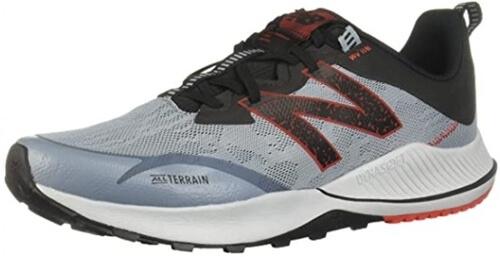
5. New Balance Dynasoft Nitrel V4
- Weight: 10.3oz.
- Drop: 8mm
- Best for: Trail/Daily Running
- Pros: Comfortable cushion, Durable, Grippy, Stable, Supportive underfoot, Lightweight, Versatile use
- Cons: Tight-fitting
The Nitrel V4 from New Balance is centered on delivering exceptional grip, pace, and style in a light package. As a result, this is an ideal shoe for a reliable and affordable trail running shoe. Furthermore, the New Balance Nitrel V4 is made from quality materials for maximum comfort and enduring performance, whether on the streets or trails.
New Balance is a top-rated athletic footwear brand manufactured in the United States. However, the company employs more than 5000 people worldwide and has five factories and nine other plants abroad. It’s one of the few athletic shoe brands that continue to produce shoes domestically.
This running shoe model is made with a DynaSoft midsole and an AT TREAD outsole to ensure maximum performance for trail running enthusiasts. The Nitrel V4 sports a sleek design with a lace closure system for a secure fit that’s comfortable to wear. Its engineered mesh upper construction provides ventilation, keeping the foot dry and cool even during intense activities. The upper also contours around the foot, giving support through its gusseted tongue and comfortable collar. The laces are standard in design but have flat laces that stay tied. With its M-strike technology, runners can enjoy improved toe-off and propulsion as well as a smoother stride transition.
Best Lightweight Trail Running Shoes
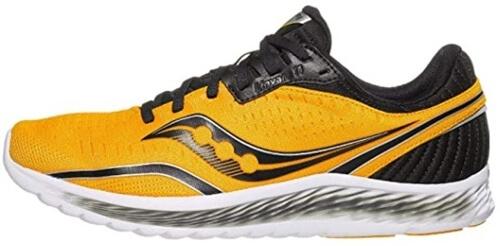
6. Saucony Kinvara 11
- Weight: 17.6oz
- Drop: 4mm
- Best for: Running
- Pros: Very light, extremely comfortable, speedy, and responsive
- Cons: Not supportive at faster pace
The most significant update Saucony has made in the Kinvara 11 is a new midsole foam, PWRRUN+, which the brand claims are lighter than its previous cushion, PWRRUN. The result is a road shoe that weighs about two ounces less than the earlier version, for a total of 17.6 ounces in men’s size 11 and 14.6 ounces in women’s size 8.
The Kinvara also retains its low heel-to-toe drop (4mm), which gives it a fast feel, with a 6mm offset from heel to forefoot. Runners accustomed to more traditional running shoes may find this change challenging at first. Still, runners who want an energetic ride will enjoy the added connection to the ground and a faster turnover rate.
The Kinvara’s shoe collar features Saucony’s Formfit technology, which provides a snug fit around the ankle while still allowing plenty of room in the toe box. In addition, the mesh upper is breathable and lightweight and fits like a glove-like sock.
We loved racing in the Kinvara 11. It felt fast, light, and responsive. The only downside was that it’s not quite supportive enough for faster paces on long runs. So if you’re looking for a do-it-all shoe that can handle everything from track workouts to 50 miles per week, this is your shoe.
Best Stability Trail Running Shoes
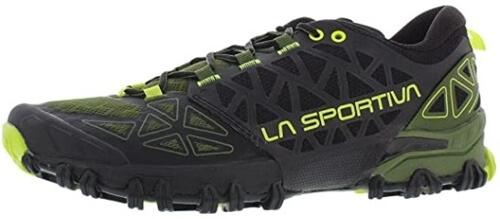
7. La Sportiva Bushido II
- Weight: 21.9oz
- Drop: 6mm
- Best for: Trail Running
- Pros: Good protection and sensitivity, Outstanding stability
- Cons: Fit is small
The Bushido II is a versatile all-mountain that offers exceptional traction and shock absorption. This shoe’s combination of outstanding cushioning and protection, incredible grip on technical terrain, and all-day comfort makes it an excellent choice for trail runners, peak baggers, and endurance hikers alike.
La Sportiva’s Impact Brake System (IBS) is designed to provide superior traction on steep, technical terrain. The lugs underfoot wrap around the midsole, which offers more surface area for increased grip on rocks and roots. In addition to providing extra grip, the IBS promotes a rolling motion that reduces impact force by 20% compared to standard outsoles.
The FriXion XT V-Groove2 outsole features dual-compound rubber that offers top-notch traction in both wet and dry conditions. These shoes will stick to practically any surface underfoot, from fields to sandstone slabs and everything in between.
Seamless upper construction provides a supportive fit without the risk of hot spots or blisters. A gusseted tongue keeps out dirt and debris while providing ample ventilation when you’re working hard uphill or running on hot days. The padded collar adds comfort while also keeping rocks from slipping into your shoes when you’re running.
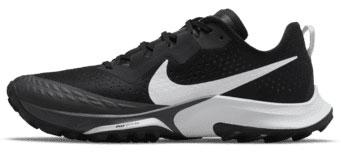
8. Nike Air Zoom Terra Kiger 7
- Weight: 10.91oz
- Drop: 4.5mm
- Best for: Running on hardpack
- Pros: Lightweight, Stable, Sensitive
- Cons: Slick surface traction
The Nike Air Zoom Terra Kiger 7 is a comfortable, cushioned light trail shoe with a moderately flexible forefoot. It has enough protection and stability to handle most terrain, but the lack of a rock plate and shallow lugs mean it’s not as adept at handling sharp rocks as some other shoes. Also, the shoe is well cushioned and still feels light and nimble.
A full-length Phylon foam midsole and exposed Nike Air Zoom unit in the heel provide a responsive ride without feeling too squishy. The outsole has deep lugs that grab onto loose dirt and rocky terrain but are not quite aggressive enough for technical sections of trail.
They feel best on rolling single track with a mix of smooth surfaces and loose dirt or mud. The Terra Kiger also has two small rubber pods on either side of the forefoot to help traction on wet surfaces, though these don’t make much of a difference on slick rocks or roots.
Overall, we recommend this shoe for runners who love trails and mix in some pavement miles. It’s versatile enough to take you from the road to dirt and back again with ease.
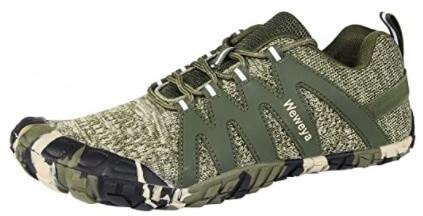
9. Weweya Barefoot Shoes Minimalist
- Weight: 10.8oz.
- Drop: 0mm
- Best for: Lightweight Running
- Pros: Minimalist, Durable, Comfortable to wear
- Cons: Zero Drop takes some getting used to
The Weweya barefoot shoes are a minimalist and zero-drop shoe designed to let your feet move naturally, allowing them to flex and bend in ways that they’d do when you were barefoot. This means that these shoes are very healthy for you, giving you better balance and posture, which will help improve the rest of your body.
They also work well as running shoes because they’re pretty flexible and lightweight while still durable. They’re made with materials that breathe, so your feet will stay cool, and they have a non-slip sole that’ll help keep you on your feet, even on slippery surfaces. The wide toe box will keep your toes from getting cramped, too.
One of the best things about these shoes is how comfortable they are. They only weigh around 10 ounces, so it feels like you’re not wearing anything at all while still protecting your feet from sharp rocks and debris. You’ll have no fit or comfort issues with these shoes because the design is so simple, but there are a few potential problems with them.
The main issue is that there are no separate slots for your toes inside these shoes and the zero drop can take some time to get used to. However, if these don’t sound like an issue to you then these are the perfect shoes.
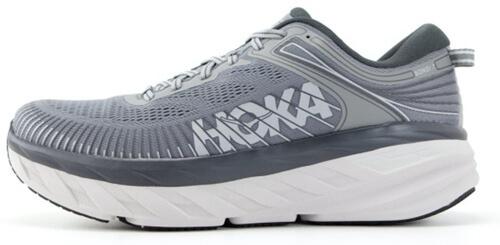
10. HOKA ONE ONE Bondi 7
- Weight: 10.7oz
- Drop: 4mm
- Best for: Everyday training
- Pros: Wide and stable midsole, memory foam collar in shoe, lots of arch support
- Cons: Upper fits narrow
The Bondi 7’s thick cushioning and padded heel collar make it a comfortable choice for long days on your feet. The cushioning takes some getting used to; it feels like you are constantly bouncing back from each landing. But once you get used to it, it feels very natural. In addition, the midsole provides plenty of underfoot protection that lets you run faster and longer without feeling beat up.
The Bondi was initially designed as a stability shoe, but the latest version is now neutral. It’s thick cushioning is better suited to daily runs and casual fitness than speedwork. In addition, the midsole foam has a dense, slow feel that doesn’t let you push off quickly with each step.
A rubberized toe cap protects against kicks and bumps to the front of the shoe. A full-length EVA midsole is highly shock-absorbent and light. You’ll also get a heel bevel, a cut at the bottom of the heel that creates a smoother transition from heel to forefoot.
An outsole of high-abrasion rubber increases traction and durability on roads and trails. Patterned lugs on the outsole help improve grip, especially in slippery conditions. In addition, the Bondi 7 has a 5mm offset, so your heel sits higher than your toes for a stable ride.
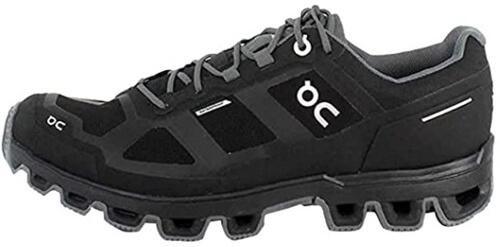
11. On Running Cloudventure
- Weight: 21.8 oz
- Drop: 6mm
- Best for: Hard Packed Running/walking
- Pros: Stylish, comfortable, quality construction
- Cons: Rocks can get stuck in between the treads
The Cloudventure shoe by On Running is coming in as number 11 on our best trail running shoes of 2025. The Cloudventure is made with 100% waterproof materials, guaranteeing to keep your feet dry no matter how long you are out on the trails.
On Running’s Cloudventure construction protects the toes while remaining lightweight and flexible because of the rubber. As a result, the Grip-Rubber profile of the Cloudventure performs in the most demanding conditions. In addition, the heel-to-toe drop of the Cloudventure is 4mm. This drop allows for a natural footstrike as well as plenty of cushioning underfoot without feeling like you’re wearing bulky trail running shoes.
The lacing system features a traditional tongue design. And, with a single pull cable that runs outside to inside through eyelets on either side of the shoe, they are comfortable and easy to wear.
Plus, the ankle collar is generously padded around the heel and Achilles tendon. It keeps debris from entering your shoe while you run, as well as provides a cushion for your heel when descending at speed.
The CloudTec outsole is designed to disperse impact forces away from your foot while providing a cushioned landing in every step. In addition, the pods follow the natural curvature of your foot, allowing for a smooth running motion.
At the Camping Feed, we love this shoe, and you can see why!
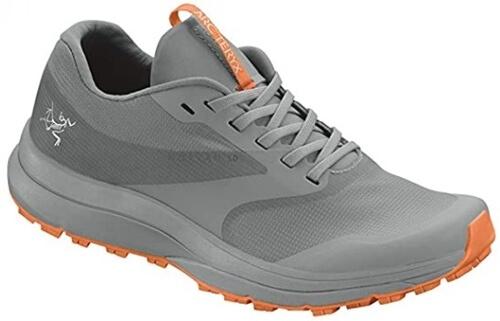
12. Arc’teryx Norvan LD GTX
- Weight: 5.7oz.
- Drop: 7mm
- Best for: Trail Running
- Pros: Ultra-lightweight, grippy, surprisingly durable
- Cons: Tight Fitting
Arc’teryx’s Norvan LD GTX is a fantastic trail running shoe, which is one of the many reasons why we’ve included it on the 2025 list.
Arc’teryx is known for its high-quality outdoor gear, and its clothing line is no exception. They make everything from base layers to jackets, pants, shorts, to trail shoes.
The new Norvan LD GTX is an incredibly versatile trail running shoe that can take you from running along technical trails to hiking in wet conditions without skipping a beat.
This shoe has a GORE-TEX upper with a highly breathable membrane to keep your feet dry and comfortable on the trail. And the Vibram outsole provides plenty of traction while remaining flexible enough to adapt to uneven terrain.
The EVA midsole adds cushioning, so you’re never left feeling sore after making those last few steps towards your destination!
If you’re looking for a trail running shoe that can take you off the beaten path — or through wet weather — and keep your feet dry, this is it. These shoes are fantastic! You can wear them all the time because they are made healthy and comfortable. They are so light, and they feel like you are not wearing anything.
We recommended these for running and hiking at the Camping Feed, but it’s important to note that they do have enough support to wear all day. Arc’teryx’s Norvan LD GTX is an excellent shoe for anyone who wants a lightweight, comfortable shoe for running and hiking.
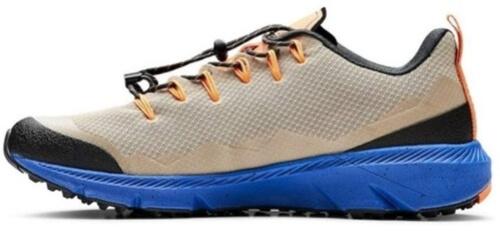
13. Craft Nordic Speed Shoes
- Weight: 8.81oz
- Drop: 9.5mm
- Best for: Trail Running
- Pros: Excellent build quality, robust
- Cons: Slippery on wet surface
Nordic Speed is a brand new kind of all-terrain running shoe that combines durability, cushioning, and traction into one package. It’s built for high-intensity runs on rough off-road surfaces.
With this footwear, you will find yourself in a completely new world of running, where you can comfortably run-off-road and enjoy the natural feeling of the trail on your feet.
Craft’s Nordic Speed is one of the more stable running shoes on the list. It has a comfortable fit, and the full-length ARC midsole provides excellent cushioning and shock absorption.
The shoe’s outsole features a non-slip triangular profile that helps provide more traction on uneven surfaces. Nordic Speed is the perfect companion for runs over rough ground. They are a comfortable and highly effective shoe for your next trail run.
These shoes can withstand even the most challenging terrain, featuring a speed-lace fastening system, reinforced heel, and toe cap for added protection and durability.
These shoes are durable, lightweight, and offer excellent traction on rough off-road surfaces with a robust knitted upper. We love everything that Craft has done to make the Nordic Speed a durable shoe for the trails at the Camping Feed.
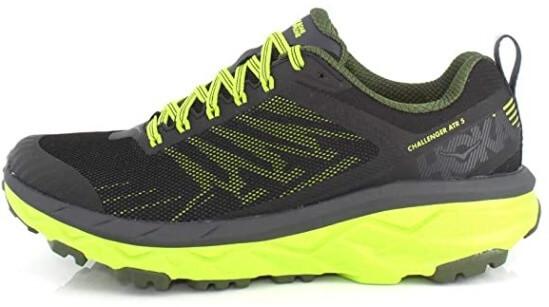
14. Hoka One Challenger ATR 5
- Weight: 9.4oz.
- Drop: 5mm
- Best for: Trail Running
- Pros: Sticky, grippy traction, the best underfoot protection, lightweight for so much shoe, now comes in D or EE widths, sheds water very well
- Cons: Narrow in forefoot and wide in heel
The fifth iteration of the Challenger offers more arch support, more cushioning, and more comfort than ever before. As a result, the Hoka Challenger ATR 5 delivers a perfect balance of grip and cushioning for runners who are not content to stay on the pavement.
With the ATR 5, you can finally get a modern sticky rubber outsole. However, the ATR 5 goes above and beyond other trail shoes in its supersoft cushioning.
With so much cushioning underfoot, this model is designed to perform well both on trails and on roads or bike paths, making it perfect for those who run on mixed terrain regularly. In addition, the midsole geometry ensures a smooth ride on the road because we know you can’t always avoid pavement altogether.
The Challenger ATR 5 trail-running shoes have been redesigned to make them lighter and faster, just in time for the spring running season. In addition, wider lugs on the outsole allow for a smoother ride on the road and a more confident feel on the trail.
At the Camping Feed, we love that you can experience all-terrain performance with our Hoka Challenger ATR 5. This versatile shoe works with your foot’s natural gait on variable terrain from mountain trailhead to the street side.
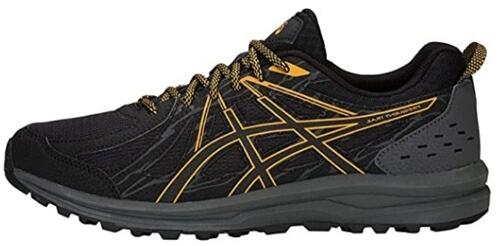
15. ASICS Frequent Trail
- Weight: 10.12 oz
- Drop: 8mm
- Best for: Trail Runs
- Pros: Comfortable, Stable, Durable, Responsive
- Cons: Short shoelaces
The ASICS Frequent Trail is a neutral running shoe designed specifically for more accessible, lighter trail runs. They incorporate technical features that deliver lasting comfort, protection, and support for optimal performance.
These versatile shoes are designed to deliver enhanced performance and maximum comfort and support. The Frequent Trail is a good choice for runners and athletes seeking a lightweight yet sturdy shoe to accompany them on the roads and trails.
The Frequent Trail boasts breathable mesh fabric to help wick away moisture and allow for continuous airflow. And the synthetic leather overlays provide durability.
The soft midsole foam is used for underfoot comfort, while a highly durable outsole with an aggressive lug pattern is added for a firm grip on wet and dry terrain.
We know your run is essential to you at the Camping Feed. So, we present you with a pair of running shoes that will help you enjoy trail running sessions more. ASICS Frequent Trail running shoe provides the perfect solution for runners seeking a trail-friendly yet versatile sneaker.
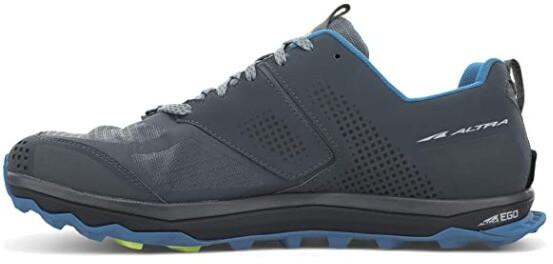
16. ALTRA Lone Peak 5
- Weight: 11.1oz.
- Drop: 0mm
- Best for: Trail Runner
- Pros: Well-cushioned, breathable, sensitive
- Cons: Wide fit
The Altra Lone Peak 5 is one of the most popular running shoes and will be an excellent fit for any runner looking to get into the sport.
Altra was one of the first brands to introduce zero-drop footwear, which refers to having a heel stack height equal to your forefoot stack height. This provides an equal amount of cushion under both your heel and forefoot. The minimalist design results in increased stability and balance, allowing your toes to splay naturally during toe-off for added comfort.
The Lone Peak 5 is Altra’s premium trail running shoe. Featuring a thick midsole and outsole, the Lone Peak 5 is an excellent option for anyone who is ready to hit the trails in 2025!
This version of the Lone Peak features an all-new upper design, and the midsole features an improved StoneGuard material. As a result, the Lone Peak 5 is an excellent choice for anyone looking for a shoe with a wide toe box, balanced cushioning, and durable components.
The Altra Lone Peak 5 is an excellent shoe for those looking for a neutral zero-drop shoe. It’s not exceptionally as cushioned as some other models on this list, but it offers excellent performance while still comfortable enough to wear all day long.
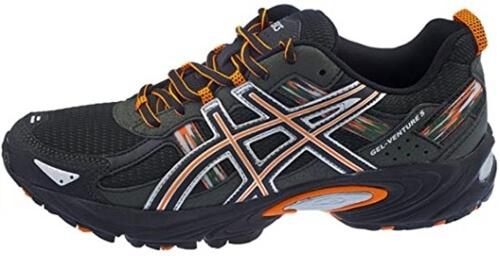
17. ASICS GEL Venture 5
- Weight: 10.7oz.
- Drop: 10mm
- Best for: Trail
- Pros: Durable construction, Roomy toe box, Effective arch support
- Cons: Not flexible enough
The Asics Gel Venture 5 is categorized as a trail running shoe, but you can also use it for daily running. It has a medium to high arch structure, which makes it perfect for neutral or under pronating runners.
The upper of the Asics Gel Venture 5 is composed of synthetic leather and breathable mesh material. The leather protects the feet from outside elements that can cause harm, such as rocks and other trail debris. On the other hand, the mesh fabric promotes a cool and breathable environment for the foot.
Molded overlays are stitched onto the upper unit to provide structure and support. In addition, they ensure a snug fit, thus preventing slippage inside the shoe.
The collar and tongue are heavily padded to give more comfort to the foot. The padding also prevents chafing and irritation from occurring.
The lacing system is conventional, with metal eyelets that allow the runner to customize their fit according to their own comfort needs.
The heel counter is integrated into the shoe’s design to stabilize it upon impact. It also prevents ankle strain or injuries throughout each run.
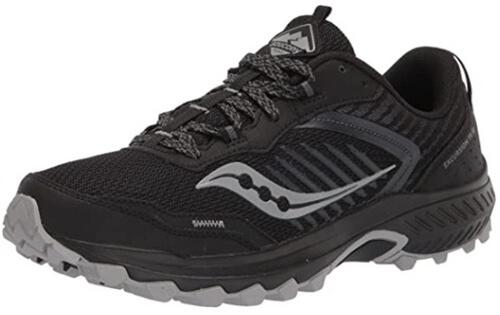
18. Saucony Excursion Tr15
- Weight: 11.3 oz.
- Drop: 8mm
- Best for:Trail/Off Road
- Pros:Light Weight, Comfortable, Durable
- Cons: slippery on concrete
We’re bringing it back to the basics. With a new, refined profile, the Excursion TR15 offers what you need for a great trail run without all the bells and whistles.
A durable mesh upper locks in the foot for protection and quick drying, while underfoot’s versatile cushioning delivers just enough comfort and responsiveness. So if you’re looking for a lightweight, reliable trail running shoe that handles every mile with ease, look no further than The Excursion TR15.
They are highly breathable. Even more critical, Saucony’s Excursion TR15 feels like an extension of your foot. As a result, they do not get in the way of any of your natural running movements on the trails. While we’re sure this is due to their design and construction, the shoe itself fits exceptionally well.
At the Camping Feed, we would recommend these shoes to anyone looking for a good trail shoe that does not get in the way of your natural stride.
This all-terrain running shoe is built to be rugged and durable yet still lightweight and responsive. The carbon rubber lugs on the outsole give you traction and stability no matter what the trail throws your way. And while they are completely comfortable, they can be a little slippery on concrete if you happen to be running on the roads. Besides that, we love these shoes!
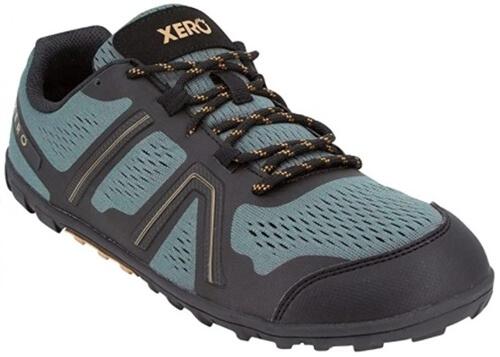
19. Xero Shoes Mesa
- Weight: 8 oz.
- Drop: 0mm
- Best for: Trail Running
- Pros: Durable Upper Construction, Maneuverable Sole, Great for Everyday Use
- Cons: Not great for muddy conditions
The Xero Shoes Mesa Trail is a new addition to its trail running lineup, and it’s the first shoe made with the revolutionary TrailFoam technology.
This 3mm layer of multi-directional cushioning works like an airbag, protecting your foot from blisters and foot fatigue throughout your run.
It’s also highly breathable and has no-slip or oil build-up to keep you comfortable in light conditions or when your feet get sweaty. You’ll find out why it performed as well as it did when tested in the varied terrain that runners put their shoes through.
The Xero Shoes Mesa Trail provides the ideal balance between trail running and training with a lightweight build, lacing system, and breathable mesh upper. The midsole layout supports a natural stride, while the flexible outsole keeps you comfortable as you explore your options. What more could you want from an everyday training shoe?
Don’t let its aesthetic and purpose-built flexibility fool you. With this lightweight, breathable shoe, Xero isn’t just focused on the outdoors—it’s also all about how you feel sitting down at a desk.
At the Camping Feed, if we had to find one major flaw of Xero’s Mesa Trail, it’s that they are not great if you’re running on trails on a rainy day. They don’t perform as well in muddy conditions. But, outside that, they’re great while running for exercise or just a few errands.
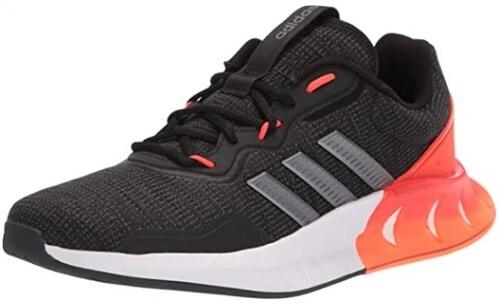
20. adidas Kaptir
- Weight: 8.25oz.
- Drop: 5-8 mm
- Best for: Everyday Use
- Pros: Perfectly comfortable, No tie laces
- Cons: Thin Insole
Adidas has been on a roll crafting sneakers that are just as suitable for running and playing basketball as for casual streetwear.
The latest to join the roster is the adidas Kaptir Super that integrates the brand’s Boost midsole into a chunky sneaker silhouette. This footwear technology was first introduced in 2013 and has since been used in many other models from the brand.
It delivers excellent responsiveness and cushioning to withstand your long walking activities. The midsole also comes with a Torsion system that allows you to transition smoothly from heelstrike to toe-off.
With the look of a trail shoe with the feel of a future-forward runner, the adidas Kaptir Super brings together the best of both worlds.
There’s another exciting thing about this shoe. The upper isn’t the conventional mesh but a fusion of Primeknit and nylon. This fabric is thick enough to withstand abrasions.
At the Camping Feed, we love that you can get these shoes without breaking the bank. And, it comes in six colorways.
Winter Shoes Buying Guide
- The right type and fit of a trail running shoe
- The difference between normal running shoes and trail running shoes
- Exact fit or one size up?
- Heel-to-toe drop
- Weight
- Waterproofing
- Can trail running shoes be used on roads?
- Protecting your toes
- Should I care about cushioned trail running shoe?
- Trail running shoes used for hiking
- What to do when the trail gets muddy
The right type and fit of a trail running shoe
Trail running is a broad term that can mean different things to different people. For some, it’s a stroll on dirt trails a few times a week, while for others, it’s an all-out vertical attack of hundreds of feet per mile. The true definition is running on trails, the purpose of which is also sort of vague. Broadly speaking and to make it easy to understand, trail running means any off-pavement running that isn’t on the sidewalk or road.
Although the definition of trail running can vary greatly, the footwear options are primarily similar with only slight variations. Most companies make a shoe designed for “easy terrain” and “technical terrain,” The latter is more aggressive with more protection and traction, and the former is more lightweight and agile. Some shoes fall between these two poles, offering good all-around performance for most runners.
Trail running shoes are an essential piece of equipment that can make your runs more enjoyable and help prevent injuries like ankle sprains or even knee problems down the line. But it’s not just about selecting the right shoe, but finding the perfect balance between you (your foot shape and gait), your shoe (its fit, shape, and cushioning), and your trail (its surface, grade, and distance).
The difference between normal running shoes and trail running shoes
Road-running shoes are made to handle miles of running on smooth surfaces, like sidewalks, roads, and track. But when you take those same shoes onto a trail, you’re asking them to do a job that they’re not designed for.
Trail-running shoes are designed to give you more grip, better stability, and more protection from the trail conditions than road-running shoes. Their outsoles feature big lugs that provide grip on rocky and rooty terrain. The uppers are reinforced for protection from rocks and sticks. And the midsoles are stiffer for stability on uneven terrain.
So, can you run trails in your road-running shoes? Sure, but it might not feel as comfortable or secure as it does in trail-running shoes. Think about it this way: If you wore your running shoes on a mountain bike ride, they’d probably get pretty beat up pretty fast. And they wouldn’t help you navigate bumpy terrain or push pedals uphill very well. Of course, you could still have fun riding in them — but if you want to get the most out of your ride, you’d be better off wearing a pair of cycling shoes that are designed for the sport. It’s the same with the trail.
Exact fit or one size up?
Your feet are the foundation of your body and how you interact with the ground, so it makes sense to pay attention to them. If you’re a trail runner, you need to find, first and foremost, a pair of shoes that fits your foot. If they’re loose or too tight, you’re going to have problems. If they don’t fit your foot type — say, if you have a high arch and the midsole is too low — then you may be in pain. But getting the right fit isn’t as simple as just putting on a pair of shoes and seeing how they feel.
Fit is more important than any other consideration. Feet are biomechanically complex, and a good fit will also account for factors like arch shape, arch length, foot volume, and more. Therefore, in general, you’ll want shoes that have as close to an exact fit and provide adequate length and width in the toe box. Our suggestion is to buy the size that fits. Most shoes are designed with extra room in the toes, so they will probably fit fine. But if you’re worried, you can try on a pair of the same model and size at a local running store to see how they feel.
Heel-to-toe drop
The heel-to-toe drop is the difference in shoe height from your heel to your toe. This can be measured in millimeters and has different effects depending on the type of shoe. This is directly related to comfort based on foot strikes. Before buying running shoes, it’s good to know what type of foot strike you have. This will help you find a pair that fits your unique stride.
If you’re a heel striker, which means the heel of your foot hits the ground first, then any shoe with cushioning in the heel will probably work for you. Most trail running shoes have some cushioning in the hike, so if this is how you run, look for a shoe that has a comfortable fit and feels good to run in. Then, go for speed or distance—whatever feels best underfoot.
If you’re a mid- or forefoot striker (meaning your mid- or forefoot lands first), then get used to looking more closely at cushioning features spread across the foot with a lower drop. In addition, you’ll want some cushioning under the ball of your foot (where those two types of strikers land).
Weight
The weight of your trail running shoes can be a deciding factor in comfort, feel, and fit. However, don’t let this be the only factor when you’re picking out your next pair. The last thing you want to do is choose a pair that isn’t comfortable or fits poorly.
A lighter shoe will help you conserve energy and feel less exhausted at the end of a long run. In addition, it allows for a quicker stride and is easier on the legs because there is less weight to carry around. However, when it comes to trail running shoes, you typically find that the lighter the shoe, the less durable it will be. And if you are looking for a shoe with lots of protection from rocks, dirt, and roots, you’ll probably have to sacrifice some weight to get it.
Many of today’s trail running shoes are designed to go long, handle technical terrain, and be worn all day. Lightweight is a significant factor in this trend, with many high-end models coming in under 9 ounces per shoe (for reference, the average weight of a men’s size nine running shoe is 10.9 ounces).
Waterproofing
There are a few different waterproof trail running shoes on the market, but they tend to break down into two categories: fully waterproof and water-resistant. The former feature a Gore-Tex membrane that lines the entire shoe (as opposed to only a specific area), while water-resistant shoes use a DWR coating or similar material on the upper to keep moisture out. Entirely waterproof shoes are the best option for wet conditions, but they generally tend to be heavier and have reduced breathability.
Fully waterproof trail running shoes are built with waterproof membranes (such as Gore-Tex) that line the entire shoe, preventing any water from getting inside. This type is best for extremely wet conditions and often includes additional features such as sealed seams and rain covers over laces. However, these shoes typically weigh more than standard models, and breathability can suffer in warm weather or strenuous efforts.
The other option is a water-resistant trail running shoe, which uses materials like DWR coatings on the upper to repel moisture and keep your feet dry when you’re running through puddles or light rain. You won’t get the complete protection of a waterproof design, but these are lighter and better ventilated.
Can trail running shoes be used on roads?
Trail running shoes have more traction, are heavier, and are designed with more support systems. The soles are beefier, and the upper is usually made of thicker leather or nylon mesh for durability. The thick sole is made for uneven surfaces, like dirt trails, but protects from sharp rocks and roots. Road shoes are lighter and have a rubber sole designed for slick surfaces.
Even if you’re not running on rough terrain, trail shoes are a good choice if your feet require a lot of support and protection. They’re also good to wear if you run on dirt roads that aren’t paved because they’ll protect your feet better than a pair of road shoes will.
Trail shoes offer many benefits over regular running shoes. They are specifically designed for the demands of off-road running and feature more aggressive treads to handle uneven surfaces and slippery terrain. Some trail shoes also have waterproof uppers to keep water out, so your feet stay dry longer during wet weather conditions. Trail shoes also come with protective mesh around the ankles and toes to keep you from getting scratched by shrubs and rocks.
If you run on unpaved surfaces frequently, trail running shoes will help protect your feet from injury while offering additional support and comfort. However, they are heavier than road running shoes; they can wear out faster if used too often on paved roads or other smooth surfaces.
Protecting your toes
If you are headed to the mountains or running a course that’s likely to have rocks or roots on the trail, you might want to consider a shoe with more substantial toe protection. You can tell how much protection a shoe provides by looking at the toe box. The more significant the toe cap is and the wider it extends on either side of the foot, the better protected your toes will be.
Something to keep in mind is what type of activity you’ll be using your trail runner for. If it’s simply for road running and no real off-road trail running, then you might want to consider a road running shoe with some light, but adequate, toe protection. However, if you plan to run on technical trails with lots of rocks, roots, and uneven surfaces, then you’ll want a shoe with better toe protection and likely a more substantial outsole unit and midsole cushioning. And we prefer some rock plate in the midsole: it won’t add much weight but will help prevent sharp rocks from poking through the bottom of the shoe on rocky terrain. In terms of construction, we prefer seamless uppers that minimize hot spots and blisters, which you can expect on longer runs.
Should I care about cushioned trail running shoe?
The short answer is yes — cushioning in a trail running shoe is essential. But the amount of cushion you need, and how you want it to feel, is up to you.
Midsole cushioning can affect the comfort, weight, and midsole fit of a shoe. The three main types of cushioning are high-energy return foams, low-energy return foams, and rock plates. A rock plate sits between the midsole and outsole and protects your foot from sharp rocks and other ground hazards. In addition, a good rock plate protects sharp objects while allowing flexibility through the forefoot.
We have found an extensive range of opinions on this, with most runners falling somewhere in the middle. Some prefer minimalist shoes and see that the cushioning level provided by most models on the market feels overkill. Others are drawn to heavily cushioned shoes that give an extremely plush feel underfoot and help protect their feet from sharp rocks and other trail hazards. For many, however, a shoe that falls in between these two extremes is the way to go. Most of us prefer some cushioning but don’t necessarily want or need a ton of it.
Trail running shoes used for hiking
The primary benefit of using trail runners for hiking is speed, comfort, and efficiency. With less weight on your feet and better flexibility, you’ll find it easier to cover the ground and use less energy. In addition, more miles means more fun!
Another benefit is balance. Hiking boots are typically much heavier than trail runners, especially when wet. So when scrambling over boulders or crossing streams, I can place my feet with greater precision in my lighter shoes, making for safer traveling.
Many thru-hikers report that swapping to lightweight trail runners reduces their foot pain and allows them to continue hiking further and further each day. The reason? All-day, heavy boots can strain calf muscles, Achilles tendons, and foot arches. Wearing a light shoe not only reduces these strains but allows your feet to flex more as you step forward. This improves proprioception (the brain’s ability to sense where your body is in space) and makes it easier to adjust your gait if you step over rocks or roots.
What to do when the trail gets muddy
Even if you’re a fast hiker, you need to slow your pace down when the trail gets muddy. It’s accessible to misstep and fall on slick surfaces, so keep your eyes on the path ahead and be mindful of your footing at all times. When the trail turns into a giant mud puddle, it’s tempting to keep walking, but this can do significant damage to your footwear. So instead, take a moment to look for an alternate route and avoid the mess altogether.
You’ll have much more fun on the trail if you accept that your feet are going to get wet, muddy, or both. If you can’t handle that, maybe trail running isn’t for you. You may also want to invest in a good pair of trail running shoes with aggressive tread (and possibly a gaiter) that will give you extra grip on the trail. If you bring your favorite pair of sneakers out on the trail, they’re likely to get trashed.
